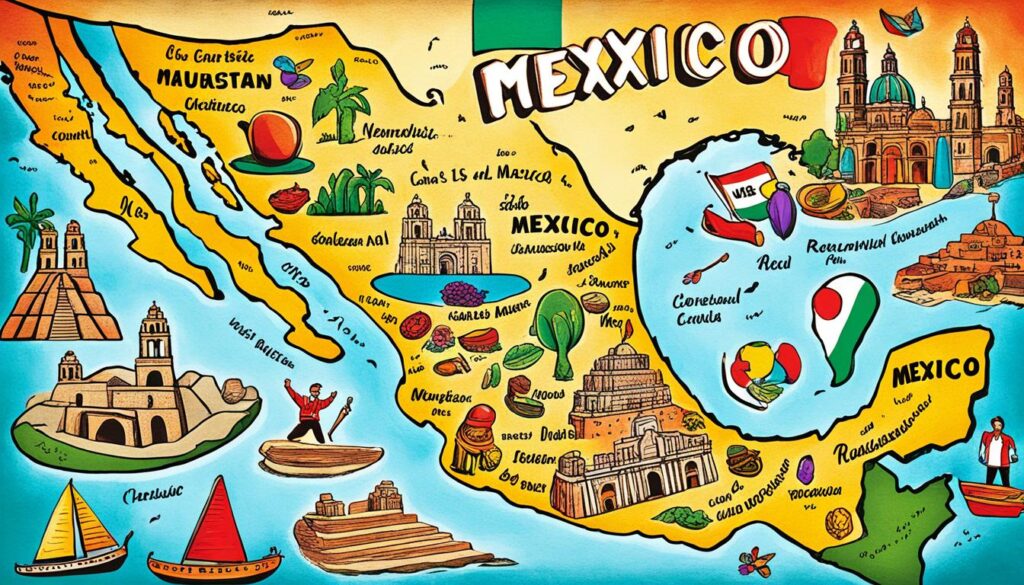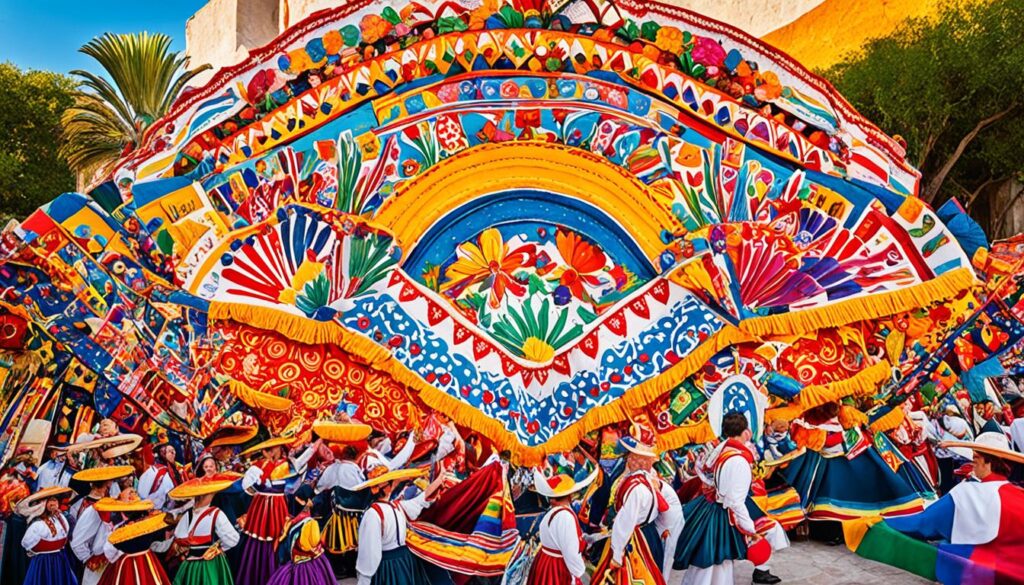I am a participant in the Amazon Services LLC Associates Program, an affiliate advertising program designed to provide a means for sites to earn advertising fees by advertising and linking to Amazon.com and affiliated sites. Privacy Policy
What Languages Are Spoken in Mexico? [Official Guide]
When Mexico comes to mind, what language do you think of? If it’s Spanish, you’re on the right track. Spanish is the top language spoken in Mexico. Most people can speak it. Yet, there are many other languages in this lively country.
Mexico is home to 68 indigenous languages. These languages help showcase the country’s diverse culture. The government works to save and spread awareness of these languages. It does this through the Law of Linguistic Rights.

With over 7 million speaking indigenous languages, they are important. However, just 6% of the population speaks them. This makes us think: What are these languages, and how do they survive?
This official guide will look at the languages of Mexico. From Spanish to lesser-known indigenous languages, we’ll cover them all. Let’s explore Mexico’s rich language and cultural diversity.
Key Takeaways:
- Spanish is the dominant language in Mexico, spoken by the majority of the population.
- Mexico recognizes 68 indigenous languages, which are protected and promoted through the Law of Linguistic Rights.
- Over 7 million people in Mexico speak indigenous languages, representing about 6% of the population.
- The preservation of indigenous languages is crucial for maintaining the cultural diversity of Mexico’s indigenous communities.
- In addition to Spanish and indigenous languages, other languages like English are also spoken in Mexico, particularly in tourist areas and cities.
Best Wireless Portable Charger Buy Here
Indigenous Languages in Mexico
Mexico stands out for its many indigenous languages. Over 130 languages are spoken across the country. These languages keep the culture and diversity of indigenous communities alive.
Nahuatl is one of Mexico’s most spoken indigenous languages. It was once the language of the Aztec people. Today, over 1.7 million speak Nahuatl in Mexico.
Then there’s Maya, spoken in the Yucatán Peninsula. Around 850,000 people speak this language. It’s a key part of the region’s cultural identity.
Mexico also has languages like Mixtec, Zapoteco, Otomi, and Tzotzil. Each language adds to Mexico’s rich language variety.
“Preserving these languages is crucial. They connect us to the deep cultural roots of indigenous Mexico. This includes keeping alive their knowledge and identity.”
Efforts are underway to keep these languages alive. Younger people are being taught their ancestral languages. This is building pride and unity in indigenous groups.
The Importance of Indigenous Language Preservation
Keeping indigenous languages alive is about more than just words. It protects the culture and identity of indigenous people. These languages pass down traditional knowledge and stories.
This helps keep a strong sense of community among indigenous groups. It fosters belonging and unity. This is one reason why it’s so important to protect and promote these languages.
In Mexico, the government supports the rights of indigenous people. The Law of Linguistic Rights, from 2003, helps protect these languages. It ensures they’re used in public sectors, schools, and the legal system.

The Linguistic Mosaic of Mexico
Mexico’s many languages show its rich multiculturalism. Each language has its own history and connection to its region. This creates a colorful tapestry of languages across the country.
Here’s a table of key indigenous languages in Mexico. It includes their language families and the number of people who speak them:
| Indigenous Language | Language Family | Approximate Number of Speakers |
|---|---|---|
| Nahuatl | Uto-Aztecan | 1.7 million |
| Maya | Mayan | 850,000 |
| Mixtec | Oto-Manguean | 500,000 |
| Zapoteco | Oto-Manguean | 450,000 |
| Otomi | Oto-Manguean | 350,000 |
| Tzotzil | Mayan | 300,000 |
Mexico’s linguistic diversity is a treasure. It shows the country’s commitment to its indigenous cultures. Through bilingual education and cultural programs, Mexico celebrates its indigenous roots.
Spanish in Mexico
In Mexico, Spanish is very important. It’s the main language for most people. It’s also used in government talks.
Spanish is key in Mexico, even though not named the official language. It’s the main language in society and culture. This shows how vital Spanish is in everyday Mexican life.
Mexican Spanish is different from Spain’s Spanish or other Latinos’. It has unique sounds and words. This makes conversations lively with its special words and sayings.
What stands out in Mexican Spanish is how polite and easy it is. Talking with Mexicans in their language feels nice. It makes learning and talking in Spanish a fun experience.

“Mexican Spanish has its own charm, reflecting the country’s rich history and cultural diversity. When traveling to Mexico, embracing the language opens up a world of vibrant experiences and deep connections.”
Other Languages in Mexico
In Mexico, many people speak Spanish as their first language. But, there are lots who speak English, especially in places like Mexico City. Knowing English is important for jobs in tourism, hospitality, and business.
Mexico also includes additional languages in its culture. You can hear German, French, and Italian in parts where their descendants live. This shows Mexico’s rich mix of people.
Mexico is also home to people who speak languages from faraway places. In some areas, you might find people who speak Arabic. There are also Chinese communities and places where African languages are heard. This shows the country’s strong links to many cultures.
In a table below, you’ll see a list of some foreign languages spoken in Mexico:
| Language | Approximate Number of Speakers |
|---|---|
| English | Approximately 12 million |
| German | Approximately 30,000 |
| French | Approximately 25,000 |
| Italian | Approximately 20,000 |
| Arabic | Approximately 15,000 |
| Chinese | Approximately 10,000 |
| African languages | Varies across different communities |
These languages in Mexico show its rich culture. They bring in many traditions and show the country’s global ties.
Conclusion
Mexico’s many languages reflect its rich culture and diverse heritage. Spanish is the main language, while indigenous groups keep their own languages alive. This adds to Mexico’s colorful and wide-ranging identity. Also, more people are learning languages like English, making Mexico even richer in words.
It’s very important to save and share the indigenous languages. These languages connect us to Mexico’s ancient past. They show how ancient civilizations saw the world. By using and protecting these languages, Mexico wants to be a place where everyone’s language and culture can thrive.
Mexico’s mix of languages is vital for its place in the world. These languages help Mexico talk to other countries and cultures. This helps with business, tourism, and partnerships. Speaking many languages makes Mexico strong in the global community.
FAQ
What languages are spoken in Mexico?
The main language in Mexico is Spanish. Most people speak it. There are also 68 recognized indigenous languages.
How many indigenous languages are spoken in Mexico?
There are more than 130 indigenous languages in Mexico. These languages come from different language groups. Nahuatl and Maya are two of the largest native languages.
What is the status of Spanish in Mexico?
Spanish is the most used language in Mexico. It’s what the government mostly uses. Even though it’s not the official language, it’s seen as the main language of the nation.
Are there other languages spoken in Mexico?
Yes, English is also spoken, mostly in tourist spots and big cities like Mexico City. You can find other European languages, such as German, French, and Italian, in small communities too.
What is the significance of linguistic diversity in Mexico?
I am a participant in the Amazon Services LLC Associates Program, an affiliate advertising program designed to provide a means for sites to earn advertising fees by advertising and linking to Amazon.com and affiliated sites. Privacy Policy
